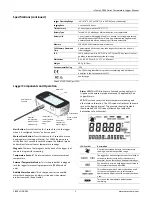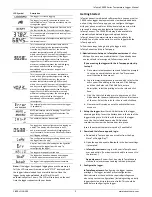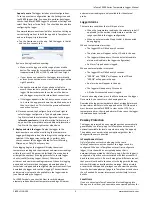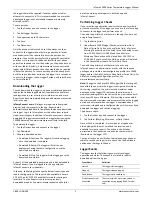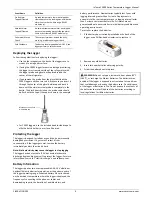
InTemp CX400 Series Temperature Logger Manual
1-800-LOGGERS 6
www.onsetcomp.com
Event Name
Definition
Probe Alarm
Tripped/Cleared
A probe temperature alarm has tripped or
cleared because the reading was outside the
alarm limits or back within range (CX402
model only).
Ambient Alarm
Tripped/Cleared
An ambient temperature alarm has tripped
because the reading was outside the alarm
limits or has cleared (CX403 model only).
Performed/Missed
Check
The user performed or missed the daily,
morning, or afternoon logger check.
Safe Shutdown
The battery level dropped below 1.85 V; the
logger performs a safe shutdown.
Deploying the Logger
Follow these guidelines for deploying the logger:
•
Use the four magnets on the back of the logger case to
mount it to a magnetic surface.
•
If using the CX402 logger for vaccine storage monitoring,
the logger must remain outside of the refrigerator with
the logger probe and glycol bottle placed inside the
center of the refrigerator.
•
If you remove the probe from the glycol bottle with a
CX402 logger and then reinsert it, make sure you insert it
through the center of the glycol bottle cap and push it
down until the stainless steel probe is completely in the
bottle. The black heat shrink on the probe cable should
be flush with the top of the cap as shown in the example.
•
For CX402 loggers, use the included double-sided tape to
affix the bottle holder to a surface if desired.
Protecting the Logger
The logger is designed for indoor use and can be permanently
damaged by corrosion if it gets wet. Protect it from
condensation. If the logger gets wet, remove the battery
immediately and dry the circuit board.
Note:
Static electricity may cause the logger to stop logging.
The logger has been tested to 8 KV, but avoid electrostatic
discharge by grounding yourself to protect the logger. For more
information, search for “static discharge” on onsetcomp.com.
Battery Information
The logger requires two user-replaceable AAA 1.5 V alkaline or
optional lithium batteries for operation at the extreme ends of
the logger operating range. Expected battery life varies based
on the ambient temperature where the logger is deployed, the
frequency of connecting to the phone or tablet and
downloading reports, the duration of audible alarms, and
battery performance. New batteries typically last 1 year with
logging intervals greater than 1 minute. Deployments in
extremely cold or hot temperatures or a logging interval faster
than 1 minute can impact battery life. Estimates are not
guaranteed due to uncertainties in initial battery conditions and
operating environment.
To install or replace the batteries:
1.
If the battery door is already installed on the back of the
logger, use a Phillips-head screwdriver to remove it.
2.
Remove any old batteries.
3.
Insert two new batteries observing polarity.
4.
Screw the battery door into place.
WARNING:
Do not cut open, incinerate, heat above 85°C
(185°F), or recharge the lithium batteries. The batteries may
explode if the logger is exposed to extreme heat or conditions
that could damage or destroy the battery case. Do not dispose
of the logger or batteries in fire. Do not expose the contents of
the batteries to water. Dispose of the batteries according to
local regulations for lithium batteries.
Black heat shrink flush
with bottle cap


